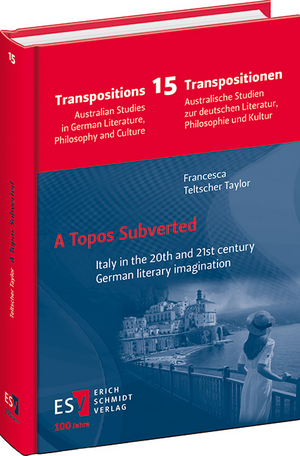
„Kennst du das Land, wo die Zitronen blühn?“
------------------------------------------------
Der Tod in Rom undermines the classical promise of aesthetic Bildung
[…]
In his refusal to accept the dominant aesthetic of Italy-narratives, Der Tod in Rom […] fractures the classical ideals of platonic love by narrating images of homosexuality much more directly than Thomas Mann did. Presentations of platonic love and Knabenliebe have played a central role in literary preoccupations with Italy, both within German literature (for instance by Johann Joachim Winckelmann and Thomas Mann) and beyond (for instance by Lord Byron, Oscar Wilde and E. M. Forster). Just as the Kürenbergs appeal to Siegfried because of their search for an aesthetic balance between Körper and Geist, the long tradition of Knabenliebe in Italy also appeals to Siegfried as being more “pure” than heterosexual love, which may be driven by a pro-creative desire. Siegfried is in fact disgusted by the thought of reproduction: “Ich sah einen Mann ein Weib begatten, und mich ekelte, weil ihre Vereinigung das Leben fortsetzen konnte” (TiR 109).
Despite not believing that he will find a sense of belonging or completeness in Rome, Siegfried is drawn to the classical model of love. He idealises platonic love and Knabenliebe, because it is grounded in the cultural authority of the ancient Greeks. Ilse Kürenberg “war ihm sympathisch, weil sie kinderlos war. Er dachte: sie hat nicht geboren, sie hat so wenig geboren wie die Statuen in den römischen Gärten geboren haben” (TiR 141). From Siegfried’s perspective, the heterosexual Ilse can embody a classical aesthetic. As Herwig argues (similarly to Felicia Letsch (31)):
„Während im Tod in Venedig die Gestalt Tadzios einen ebenso mythologisch überhöhten wie sexuell überformten Charakter erhält, sucht Siegfried in gegenläufiger Bewegung die Befreiung von seiner Geschlechtlichkeit in (hetero)sexueller Abstinenz. Sie alleine verspricht ihm, die Perpetuierung des sinnlosen Erdendaseins und damit den Kreislauf von Macht und Machtmißbrauch zu durchbrechen.“ (548)
Siegfried approves of Ilse Kürenberg because he desires a removed aesthetic beauty that transcends the corporeal, in line with classical ideals. But, like the Kürenbergs’ decision to move to Italy, Siegfried’s (hetero)sexual abstinence stems from his desire not to reproduce the past. His fascination with “Italy”, and his desire to model himself on the image of the homosexual artist undertaking an italienische Reise, is also exposed as a form of escapism, and contradicts his desire to confront the past through his music.
How then can Koeppen engage with the classical trope of Knabenliebe while also confronting the past? He does so by, in contrast to Mann’s aesthetic subtlety, narrating Siegfried’s sexuality explicitly. Koeppen evokes images of the character Tadzio from Der Tod in Venedig (the young boy whom Mann’s Aschenbach desires). Mann’s Aschenbach merely fantasised about Tadzio, enjoying him aesthetically like a classical statue. Siegfried, by contrast, has sex with a male prostitute. Like Mann, Koeppen develops a “mythical, religious undertone to Siegfried’s erotic adventure” but, as Pizer rightly indicates, “Siegfried’s episode is told in the first-person, undermining Mann’s ironic detachment and underscoring the frank, distinctly nonplatonic realism of the homoerotic encounter” (105). If Koeppen wishes to shock, I suggest he does so in order to expose the bourgeoisie’s tendency to turn a blind eye to “reality”, including their role in fascism. I suggest this because Koeppen links Siegfried’s homosexuality to his involvement with the Hitler youth, at which point Siegfried first became sexually interested in other boys. During his sexual encounter in Rome, Siegfried remembers
„die Jungenswelt der Ordensburg, den Geruch der großen Schlafsäle, die nackten Knabenkörper in spartanischer Erziehung im Frühnebel des Waldlaufs über den frostigen Boden gejagt, und weiter die Welt der Männerbünde, die Horte, Lager und Heime der nationalen Bewegung, auch die Kameradschaft der Soldaten […], aber mit diesen Burschen [den italienischen Prostituierten] verbanden mich Herkunft und Erziehung in unterweltlicher Weise und sie waren Erscheinungen eines schlechten Gewissens, von dem ich mich noch befreien mußte.“ (TiR 155 f.)
Here, Koeppen politicises the aestheticization of the young male body, rendering it impossible to disentangle human relations from historical reality.
The distant, classical Greek aesthetic, whereby the male appreciation of a young male body is considered an aesthetic act of a higher order than heterosexual desire, is positioned firmly into an historical context. Siegfried’s sexual desire is caught in tension between historical reality and the desire to belong in the safe, apolitical realm of aesthetic appreciation and platonic love. As Herwig observes,
„Siegfried wähnt zwar für einen Augenblick, ‘Petronius der Dichter’ zu sein, der die ‘Schönheit der Knaben’ genießt, und wandelt so auf den Spuren Aschenbachs, doch nur, um im gleichen Atemzug die Illusion krude zu durchbrechen: ‘es gibt keine Unsterblichkeit und die Schönheit verfault’.“ (546)
For Siegfried, Aschenbach’s distant appreciation is impossible, as Koeppen presents a stark counter-image to Mann’s beautiful Tadzio. Siegfried’s experience of pederastic desire is inextricably linked to the culture of the Hitler youth, and with it, to shame and guilt:
„Doch der übelste der Burschen trat in die Zelle, Wasser tropfte herab, er stank nach dem stinkenden Wasser des Tibers, wie auch das ganze Badeschiff nach diesem Wasser stank, das unter den Bohlen faulte und gluckste wie tausend gierige Münder, Flecken sprenkelten die Haut des verkommenen Jünglings, Pickel blühten rot und eitrig im schlaffen Felde des früh verdorbenen Gesichts, die Augen waren trübe […] und sein Haar war strähnig von dem stinkenden Wasser.“ (TiR 160)
I do not wish to argue, as A. F. Banoe does, that Siegfried “is plunged back into his own immaturity, the origins of his perversion, the pernicious years at the Nazi Parteischule” (131), because that would be to imply that homoeroticism is a phase—that ought to be overcome with maturity—or a disorder in the formation of identity. Rather, it seems that Koeppen draws on the theme of pederasty in order to subvert the classical aesthetic, associated with “Italy”. By radicalising Mann’s imagery of homosexual desire, Der Tod in Rom’s “frank, distinctly non platonic realis[t]” aesthetic (Pizer 105) exposes the pre-existing aesthetic as an attempt to flee to the apolitical realm of aesthetic appreciation, be that for instance in the form of platonic love, in the form of the classical appreciation of statues, or in the form of the musical institution that the Kürenbergs serve.
Der Tod in Rom’s “Italy”: literature about literature
In its search for a fitting post-war aesthetic, Der Tod in Rom radically subverts the promise of an aesthetic Bildung that can provide a harmonious alignment between oneself and the world; a promise that Mann began to question pre-war in both Der Tod in Venedig and Mario und der Zauberer. […]
Der Tod in Rom inherits a topos that has become circular, in which literature writes about literature. By articulating this circularity, Der Tod in Rom gives voice to the limitations of the topos “Italy”. Becker also identifies this circularity in Koeppen’s works, commenting:
„der Begriff der Moderne sei in Gefahr, selbst zu einem Mythos zu werden […]. Von daher lassen sich seine [Koeppens] Romane im Umfeld des Themenfeldes ‘Literatur über Literatur’ beschreiben, allesamt sprechen sie über die Bedingungen von Literatur, nicht zuletzt ihr starker intertextueller Charakter verweist darauf: Jeder der drei Romantitel ist bereits ein Zitat. So sind Koeppens Werke auch Romane über das Erzählen, sie reflektieren den Prozeß des Erzählens, wobei die Selbstreflexion des Erzählers vielfach gar zur Destruktionsarbeit am Erzählen gerät.“ (113)
As the “Italy” narrative becomes self-referential, Siegfried’s thoughts mirror this crisis of circularity, landing him back where he began:
„Ich glaube zwar; aber ich glaube, daß alles sinnlos ist. Oder nicht alles ist vielleicht sinnlos, aber daß ich hier bin, ist sinnlos, daß ich mit diesen Menschen rede, ist sinnlos, daß wir hier fotografiert werden, ist sinnlos, der künstliche Blitz ist sinnlos, meine Musik ist sinnlos, aber sie brauchte nicht sinnlos zu sein, wenn ich nur etwas Glauben hätte.“ (TiR 142 f.)
Recent history leaves Siegfried unable to believe in anything but the absurd circularity of history. As Becker suggests, “[d]ie seinen Romanen immanenten Anspielungen auf den Mythos beinhalten die Deutung von Geschichte als die Wiederkehr des Immergleichen”, evoking Nietzsche’s similarly burdensome thought of eternal repetition as seen in Also sprach Zarathustra and Die fröhliche Wissenschaft (Becker 114). Post-war, Siegfried is left without belief, but with the insight that belief is necessary in order for there to be any sense to his life.
[…]
Sie sind neugierig, wie es weitergeht? Der Titel kann hier bestellt werden.
| Zur Autorin |
| Dr Francesca Teltscher Taylor completed her PhD in German Studies at Monash University, Melbourne, Australia, under the supervision of Associate Professor Axel Fliethmann and Associate Professor Christiane Weller. In addition to publishing her own work, she has worked as an editor and has presented at conferences in Australia, New Zealand and Spain. She has taught courses in literary theory, literary and cultural history, and German language, primarily at Monash University and at the University of Melbourne. Currently, she works as a research affiliate at School of Languages, Literatures, Culture and Linguistics. |
 |
A Topos Subverted. Italy in the 20th and the 21st century German literary imagination Von Francesca Teltscher Taylor What has become of the literary topos “Italy”—once so central to German literature—in the 20th and early 21st centuries? Does it still have a role to play in the German self-understanding and in what way has this role changed? To address these questions, this study focusses on six texts. Each text revises, subverts, and radicalises this literary topos such that it gains new contemporary relevance and speaks to the themes of intertextuality, memoria, gender, and imagination. Culturally, the German speaking world continues to define itself in relation to its southern European neighbours: the authors continue their cultural mapping along a North-South divide, with the intellectual geography of Europe maintaining its relevance. |
Programmbereich: Germanistik und Komparatistik
